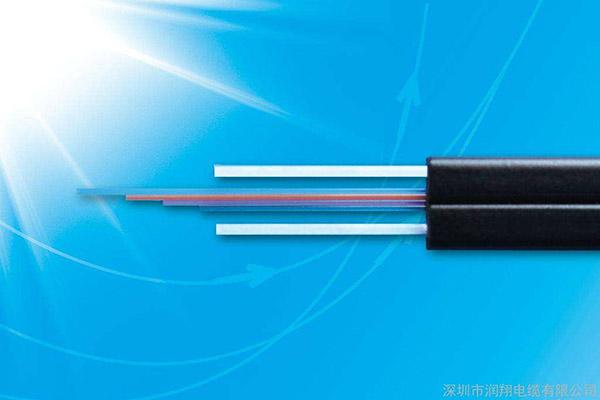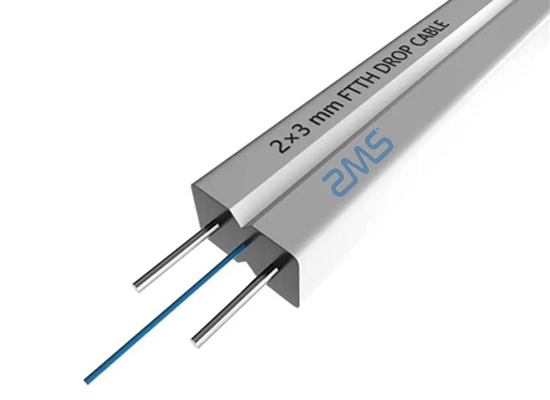I. Preface
With the development of optical communication networks and the deepening of fiber-optic access, FTTH network construction is growing exponentially. At present, China Telecom and China Netcom have clearly indicated that they will invest heavily in the large-scale commercialization of FTTH. From this series of circumstances, the focus of fiber optic communication network construction will shift to FTTH in the next few years. The new generation of all-optical networks requires fiber optic cable as an optical signal transmission medium to provide wider working bandwidth, higher transmission rate, and longer transmission distance. It should also have a long service life and be easy to install and maintain.

II. Development trend of FTTH fiber optic cable
With the continuous development of FTTH network construction, there will be more and more new varieties of fiber optic cables for the FTTH network, and fiber optic cables specially designed to adapt to various special occasions will come into being. Introduction, branching, and convenient wiring will be the main considerations of the new structure of fiber optic cable. The compact structure of fiber optic cable, convenient branching, installation and wiring, and strong versatility will be the future development trend of fiber optic cable for the FTTH network. The realization of three networks in one multi-cable mix will gradually reduce.
As the application of fiber optic cable continues to expand, the fiber optic communication network continues to extend to the terminal. The structure of fiber optic cable is also improving, new varieties of fiber optic cable are constantly introduced, which has been transformed from the traditional structure to the direction of the traditional structure-based multi-bell structure. But the change in fiber optic cable structure cannot be separated from the requirement of a suitable laying environment, the requirement of easy construction and safety and reliability, and the requirement of cost reduction and resource-saving.
The development of FTTH undoubtedly brings new opportunities for the renewal and development of fiber optic cable technology, and at the same time presents new challenges to the traditional fiber optic cable technology. The current development trend of FTTH fiber optic cable is mainly reflected in the following aspects.
1. Diversification of fiber optic cable structure
From the perspective of the fiber optic cable currently used in FTTH networks, it is the part with the most varieties of applied fiber optic cables. This part of fiber optic cable needs to adapt to the dense branching and diverse environmental conditions of the network. Diversification of fiber optic cable structure is a major feature of the future development of FTTH fiber optic cable.
2. Miniaturization of fiber optic cable structure
The miniaturization of fiber optic cable structure has been the trend of fiber optic cable development, the smaller the structure of fiber optic cable. The smaller the structure of fiber optic cable, the fewer materials used, the less space occupied by pipeline resources, the lower the cost of network construction, more convenient construction and laying, and more friendly to the environment. So whether from the user, engineering and manufacturing will promote the development of fiber optic cable structure in the direction of miniaturization.
3. Convenient and reliable branching
With the development of FTTH, the density of fiber optic cable branches is increasing, and the traditional branching of fiber optic cables will bring endless hidden problems to the network. Tap point will become the most fault factor in the future network. In order to improve the reliability of the network and the convenience of maintenance, reducing the fiber optic cable connection points is the most effective way. Suitable for branching, reducing the splicing of fiber optic cable will increasingly receive network design, engineering construction, operation, and maintenance of the favor.
4. Convenient and fast wiring
In the FTTH network, the integrated indoor cabling will need fiber optic cable that is suitable for convenient and fast cabling. Easy to install, easy to connect, and handle fiber optic cable will be the main consideration for the future design and application of fiber optic cable structure.

III. FTTH fiber optic cable products
Several types of typical FTTH fiber optic cables are as follows.
(1) FTTH indoor suspended fiber optic cable (skin cable)
Suitable for indoor wiring use, stable and reliable performance. It is produced with small bending radius fiber and has excellent anti-bending performance. Construction is safe and reliable, can be treated like copper cable, not easy to have construction failure. No tools can be stripped fiber optic cable, fiber optic cable is easy to fix, low installation costs. The specific structure of FTTH indoor suspended fiber optic cable.
(2) Self-supporting “8” wiring cable (skin cable)
Compact structure, soft, easy to build, easy to fix the fiber optic cable. Suspension parts and fiber optic units in the home separation, fiber optic units directly into the home, eliminating indoor and outdoor fiber optic cable transfer. No need to set up hanging wires and hooks when laying, high construction efficiency, and low construction cost. The specific structure of the 2-core suspension cable is suitable for the overhead introduction of fiber optic cable to independent households.
The product structure is small to meet the needs of indoor and outdoor integrated applications. The ‘8’ type structure is very easy to tear and strip. Mechanical and environmental performance can meet the application requirements. It is mainly used for the connection between outdoor branch points (such as the splitting point outside the building, and the splitting box in the building) and the user terminal ONU.
(3) Pipeline mapping fiber optic cable
Adopt full dry structure, easy to clean construction, and safe and reliable construction, not easy to have construction failure. Using small bending radius fiber production, with excellent bending resistance. The fiber optic cable outdoor indoor dual-use can be matched with a variety of connectors, fiber optic cable can be field into the end. The specific structure of the pipe mapping fiber optic cable.
(4) flexible metal tube fiber optic cable
The fiber optic cable structure is set up in the metal hose, so that the fiber optic cable’s compressive, tensile, bending performance significantly improved, while anti-rat bite damage. Bending flexibility, the minimum radius of curvature up to 10 times the diameter of the cable, can be used as easily as a cable so that the deployment of works more easily. Flame retardant. The use of laying does not require an outer sheath protection tube, not only to save space for laying the cable groove but also to facilitate the laying of fiber optic cable. The specific structure of flexible metal tube fiber optic cable.
IV. Conclusion
In conclusion, the vigorous development of FTTH will strongly promote the development of the optical cable industry, light into copper is an inevitable trend, and the arrival of FTTH network construction climax fully prepared to continuously develop new optical cable products to adapt to a variety of market demand, to contribute to the development of China’s FTTH and technological progress.
